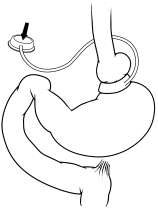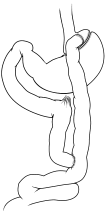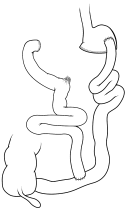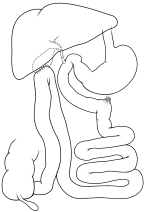Recent advances in metabolic and bariatric surgery
- PMID: 27239296
- PMCID: PMC4879937
- DOI: 10.12688/f1000research.7240.1
Recent advances in metabolic and bariatric surgery
Abstract
Obesity and its associated medical conditions continue to increase and add significant burden to patients, as well as health-care systems, worldwide. Bariatric surgery is the most effective treatment for severe obesity and its comorbidities, and resolution of diabetes is weight loss-independent in the case of some operations. Although these weight-independent effects are frequently described clinically, the mechanisms behind them are not well understood and remain an intense area of focus in the growing field of metabolic and bariatric surgery. Perceptions of the mechanisms responsible for the beneficial metabolic effects of metabolic/bariatric operations have shifted from being mostly restrictive and malabsorption over the last 10 to 15 years to being more neuro-hormonal in origin. In this review, we describe recent basic and clinical findings of the major clinical procedures (adjustable gastric banding, vertical sleeve gastrectomy, Roux-en-Y gastric bypass, and biliopancreatic diversion) as well as other experimental procedures (ileal interposition and bile diversion) that recapitulate many of the metabolic effects of these complex operations in a simpler fashion. As the role of bile acids and the gut microbiome on metabolism is becoming increasingly well described, their potential roles in these improvements following metabolic surgery are becoming better appreciated. Bile acid and gut microbiome changes, in light of recent developments, are discussed in the context of these surgical procedures, as well as their implications for future study.
Keywords: Bariatric surgery; Metabolic surgery; Morbid obesity; Roux-en-Y gastric bypass; adjustable gastric banding; bile diversion; biliopancreatic diversion; ileal interposition; vertical sleeve gastrectomy.
Conflict of interest statement
No competing interests were disclosed.
Figures






Similar articles
-
Bariatric surgery and bone disease: from clinical perspective to molecular insights.Int J Obes (Lond). 2012 Nov;36(11):1373-9. doi: 10.1038/ijo.2012.115. Epub 2012 Jul 17. Int J Obes (Lond). 2012. PMID: 22828943 Review.
-
Conversion of failed gastric banding into four different bariatric procedures.Surg Obes Relat Dis. 2012 Jul-Aug;8(4):400-7. doi: 10.1016/j.soard.2011.06.009. Epub 2011 Jun 30. Surg Obes Relat Dis. 2012. PMID: 21937286
-
Surgery for obesity.Curr Opin Gastroenterol. 2005 Nov;21(6):679-83. doi: 10.1097/01.mog.0000182859.04046.0e. Curr Opin Gastroenterol. 2005. PMID: 16220044 Review.
-
An Update on Bariatric Surgery.Curr Obes Rep. 2014 Sep;3(3):316-20. doi: 10.1007/s13679-014-0111-1. Curr Obes Rep. 2014. PMID: 26626761
-
Role of gut microbiota, bile acids and their cross-talk in the effects of bariatric surgery on obesity and type 2 diabetes.J Diabetes Investig. 2018 Jan;9(1):13-20. doi: 10.1111/jdi.12687. Epub 2017 Jun 12. J Diabetes Investig. 2018. PMID: 28434196 Free PMC article. Review.
Cited by
-
Novel developments in vagal afferent nutrient sensing and its role in energy homeostasis.Curr Opin Pharmacol. 2016 Dec;31:38-43. doi: 10.1016/j.coph.2016.08.007. Epub 2016 Sep 2. Curr Opin Pharmacol. 2016. PMID: 27591963 Free PMC article. Review.
-
Metabolic Changes Up to 10 years After Gastric Bypass.Obes Surg. 2018 Jun;28(6):1636-1642. doi: 10.1007/s11695-017-3064-0. Obes Surg. 2018. PMID: 29235010
-
Assessing Nutritional Deficiencies in Bariatric Surgery Patients: A Comparative Study of Roux-en-Y Gastric Bypass versus Sleeve Gastrectomy.J Pers Med. 2024 Jun 18;14(6):650. doi: 10.3390/jpm14060650. J Pers Med. 2024. PMID: 38929871 Free PMC article.
-
Ultra-Early and Early Changes in Bile Acids and Insulin After Sleeve Gastrectomy Among Obese Patients.Medicina (Kaunas). 2019 Nov 22;55(12):757. doi: 10.3390/medicina55120757. Medicina (Kaunas). 2019. PMID: 31766784 Free PMC article.
-
The Effects of Laparoscopic Sleeve Gastrectomy on the Parameters of Leptin Resistance in Obesity.Biomolecules. 2019 Sep 25;9(10):533. doi: 10.3390/biom9100533. Biomolecules. 2019. PMID: 31557979 Free PMC article.
References
Publication types
Grants and funding
- P60 DK020593/DK/NIDDK NIH HHS/United States
- R01 DK091748/DK/NIDDK NIH HHS/United States
- R01 DK105847/DK/NIDDK NIH HHS/United States
- P30 DK058404/DK/NIDDK NIH HHS/United States
- U2C DK059637/DK/NIDDK NIH HHS/United States
- R01 DK070860/DK/NIDDK NIH HHS/United States
- R24 DK096527/DK/NIDDK NIH HHS/United States
- F32 DK103474/DK/NIDDK NIH HHS/United States
- P30 DK020593/DK/NIDDK NIH HHS/United States
- R01 DK100431/DK/NIDDK NIH HHS/United States
- UL1 RR024975/RR/NCRR NIH HHS/United States
- UL1 TR002243/TR/NCATS NIH HHS/United States
LinkOut - more resources
Full Text Sources
Other Literature Sources
Research Materials

